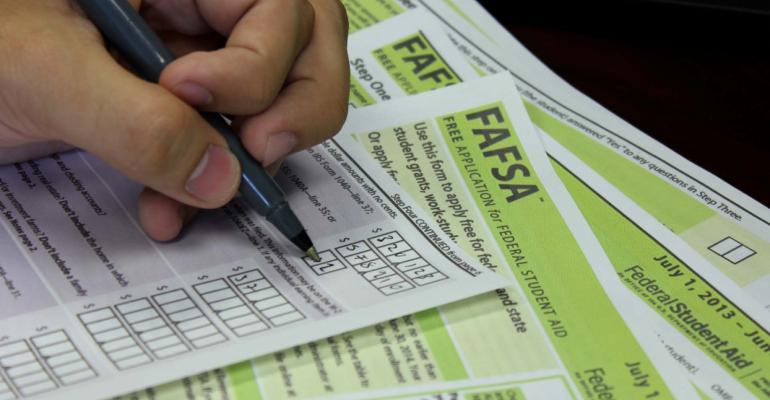The financial aid season has arrived. In the next few months, millions of parents will be completing financial aid applications.
Here are nine basic steps that your clients should know about filing for financial aid:
1. The major aid application is the Free Application for Federal Student Aid or FAFSA.
The FAFSA is the federal form that families must complete if they want to qualify for federal or state financial aid. The vast majority of colleges and universities, including more than 99 percent of state schools, also use the FAFSA to determine who will get their own institutional aid.
2. The CSS/Financial Aid PROFILE is the aid application that 229 mostly private colleges use. Here is the list of the PROFILE schools, which includes many of the nation’s brand name schools.
Many parents are puzzled about why they have to fill out the PROFILE when they have already completed the FAFSA.
The reason is, PROFILE schools use this second form to determine who gets their own in-house financial aid. These schools don’t believe the FAFSA delves deep enough into a family’s finances, so they use the PROFILE to pose more questions.
The PROFILE schools, however, do rely on the FAFSA to determine who qualifies for federal and state aid.
3. Traditionally, the financial aid filing has been very rushed. Until recently, the FAFSA was always released on Jan. 1, which led to a scramble for parents to complete their taxes so they would have the figures they needed to complete their aid applications.
But thankfully, the need to scramble has vanished. The FAFSA, as well as the PROFILE, now require parents to use two-year-old tax returns, which you’ll see referred to as “prior-prior taxes.”
4. Coupled with the use of older tax returns that everyone has long ago completed, parents can now also file their forms as early as Oct. 1, three months earlier than in the past.
Typically it’s best to file for financial aid on Oct. 1 or as soon as possible after that date. One reason not to dawdle is because some states, such as Illinois, Kentucky, North Carolina, Vermont and Washington, dispense money to eligible students on a first-come, first-served basis until the money runs out. In addition, some states, such as California, impose early deadlines. Some universities also dispense money until it runs out.
5. The use of two-year-old taxes can be a problem for parents whose income was much higher than it is now. For instance, a parent might have had a high-paying job but got laid off and is now making a fraction of his or her former income.
These parents, however, have an option. They can ask the colleges for a professional judgment. College financial aid administrators have the ability to adjust a student’s aid amount based on information that isn’t reflected in the aid application. Not all schools will do so, but it’s worth a try.
6. To file the FAFSA, this is the information that parents will need:
- Two-year-old federal income tax return;
- W-2 forms;
- Most recent non-retirement investment/bank accounts; and
- Untaxed income records.
Here is the information students will need to provide:
- Social Security card;
- Driver’s license;
- Federal income tax return;
- W-2 form;
- Untaxed income records; and
- Current non-retirement investment/bank account.
7. A question that many parents wonder about is: Can my child file for financial aid as an independent student?
It’s easy to understand why this would be an attractive option. A student typically would have little assets or income and therefore would be more likely to qualify for financial aid.
It’s extremely difficult, however, for students to be eligible to file for aid independently even if they are living on their own and paying their own bills.
Here are the main criteria for a student to be able to file for aid independently:
- Student must be 24 years of age in the year of the filing.
- Student is married.
- Student is working on an advanced degree.
- Student is a veteran or in the military.
- Student has a legal guardian.
8. In divorce and separation, the custodial parent needs to file the FAFSA. The FAFSA definition of custodial parent is unusual. This parent is the one with whom the child has lived the majority of a 12-month period ending on the day the FAFSA is filed.
Let’s say the FAFSA is submitted on Nov. 15, 2017. The parent who completes the form would be the one who took care of the child for more than six months going back to Nov. 15, 2016.
If financial aid is a possibility, it makes sense for the parent with the least assets and the lowest income to be the custodial parent. Who pays child support or claims the child on tax returns is irrelevant in determining who is the custodial parent.
The FAFSA rules on divorce also apply to separated parents.
The PROFILE rules on divorce and separation are different. Most PROFILE schools will also require financial information from the noncustodial parent. When this information is required, parents must complete a document called the Noncustodial PROFILE.
9. Resources exist for parents who need help filing the FAFSA and the PROFILE.
The toll-free number for the FAFSA is (800) 433-3243. The toll-free number for the PROFILE is (844) 202-0524.
The Khan Academy offers step-by-step guides, narrated by Stanford University’s financial aid director, on how to complete the FAFSA and the PROFILE.





